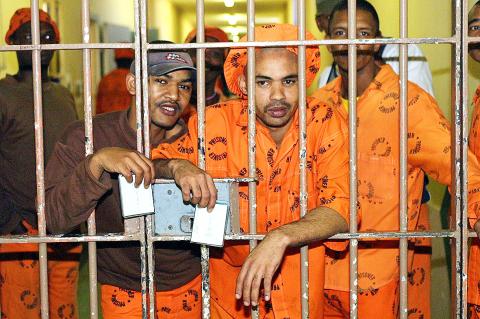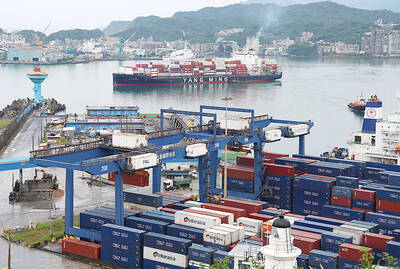Cape Town is known for the diversity of its restaurants, but the strangest has to be at Pollsmoor Maximum Security Prison, once home to South Africa’s liberation icon Nelson Mandela.
The Pollsmoor Restaurant — slogan: Idlanathi (“Eat with us”) — is open to the public, the waiters are prisoners, and so are most of the kitchen staff.
It is not a tourist attraction like Robben Island, where Mandela spent most of his 27 years in jail and which is now a museum.

Photo: AFP
It is just a restaurant in one of toughest prisons in the country where anyone can go for a meal — unless they would prefer the exclusive wine estate directly across the road.
Pollsmoor, set among the upmarket suburbs of Constantia Valley, is notorious not only for Mandela’s stay there from 1982 to 1988, but for the violent gangs that rule its unsanitary and overcrowded cells.
In contrast, the restaurant was spotlessly clean and almost deserted when this reporter visited for lunch, apart from a scattering of burly warders in brown uniforms and one couple from the world outside.
“The service is nice, the food is good and is very cheap,” said Arnold Daniels, a 57-year-old businessman, explaining why he and his wife Merina are regulars at the restaurant.
Did they not find it a bit odd to eat a leisurely lunch while thousands of prisoners were cooped up in nearby cells?
“It doesn’t bother us,” Daniels said. “It’s not really strange. It’s very safe and we don’t feel threatened at all.”
The decor of the restaurant, which can seat about 30 people, is, perhaps fittingly, spartan. The metal chairs have red plastic seats, the walls are bare and the floor is scrubbed tile.
However, the impenetrable security gates across the French windows are partly hidden by drapes in red and brown with gold piping, and the table mats boast a colorful African mask design.
Fans turn lethargically on the ceiling and pop music is piped continuously into the restaurant.
Wearing prison orange trousers under his apron, the waiter greets guests cheerfully and recommends the steak.
The menu is extensive, ranging from “traditional tripe” and ox head to chicken schnitzel, beef cordon bleu and a seafood platter — which, at 60 rand (US$3.80), is the most expensive dish.
The waiter said he was given four years in jail for shoplifting.
He had seven months left to serve and hoped to get a job in hospitality when he was released.
The prison would help with a reference, he said.
The food is good and the presentation worthy of a Masterchef contestant, with herbs and sauces drizzled around the plate.
After the meal, one of the cooks, also in orange prison gear under his apron, stepped into an enclosed courtyard alongside the restaurant for a cigarette.
He was serving five years for car theft, although he insisted he did not steal the car himself, simply bought it off someone else.
“But I’m lucky to only get five years, because car theft is a very serious offense,” he said.
He described working in the restaurant as “one of the best jobs in the prison,” but would not be drawn on life in the cells.
“It’s prison,” was all he would say.
Pollsmoor has about 8,000 inmates — twice its capacity — living in conditions described in a report by a judge last year as “deeply disturbing” and “inhumane and appalling.”
Tuberculosis is rife — Mandela contracted TB there — and at least one inmate died last year of leptospirosis, a disease spread by rats.
The restaurant closes at 2pm. Diners head for their cars and the gates, while the waiters and cooks are taken back to their cells and locked up until the breakfast service begins.
Across the road is another high-security, electrified fence, marking the borders of the Steenberg wine and golf estate, but that fence is designed to keep people out, not in.
Traditional Cape Dutch-style gabled white buildings with thatched roofs cluster among expansive green lawns and vineyards against a mountain backdrop.
At Catherina’s award-winning restaurant, under umbrellas on the patio, the lunch crowd is dominated by tourists from Europe and the US.
The menu boasts “sustainable” fish for its ecologically concerned up-market diners. The fish turned out to be hake — the same as that offered at the Pollsmoor prison restaurant, at four times the price.

CHIP RACE: Three years of overbroad export controls drove foreign competitors to pursue their own AI chips, and ‘cost US taxpayers billions of dollars,’ Nvidia said China has figured out the US strategy for allowing it to buy Nvidia Corp’s H200s and is rejecting the artificial intelligence (AI) chip in favor of domestically developed semiconductors, White House AI adviser David Sacks said, citing news reports. US President Donald Trump on Monday said that he would allow shipments of Nvidia’s H200 chips to China, part of an administration effort backed by Sacks to challenge Chinese tech champions such as Huawei Technologies Co (華為) by bringing US competition to their home market. On Friday, Sacks signaled that he was uncertain about whether that approach would work. “They’re rejecting our chips,” Sacks

Taiwan’s exports soared 56 percent year-on-year to an all-time high of US$64.05 billion last month, propelled by surging global demand for artificial intelligence (AI), high-performance computing and cloud service infrastructure, the Ministry of Finance said yesterday. Department of Statistics Director-General Beatrice Tsai (蔡美娜) called the figure an unexpected upside surprise, citing a wave of technology orders from overseas customers alongside the usual year-end shopping season for technology products. Growth is likely to remain strong this month, she said, projecting a 40 percent to 45 percent expansion on an annual basis. The outperformance could prompt the Directorate-General of Budget, Accounting and

NATIONAL SECURITY: Intel’s testing of ACM tools despite US government control ‘highlights egregious gaps in US technology protection policies,’ a former official said Chipmaker Intel Corp has tested chipmaking tools this year from a toolmaker with deep roots in China and two overseas units that were targeted by US sanctions, according to two sources with direct knowledge of the matter. Intel, which fended off calls for its CEO’s resignation from US President Donald Trump in August over his alleged ties to China, got the tools from ACM Research Inc, a Fremont, California-based producer of chipmaking equipment. Two of ACM’s units, based in Shanghai and South Korea, were among a number of firms barred last year from receiving US technology over claims they have

BARRIERS: Gudeng’s chairman said it was unlikely that the US could replicate Taiwan’s science parks in Arizona, given its strict immigration policies and cultural differences Gudeng Precision Industrial Co (家登), which supplies wafer pods to the world’s major semiconductor firms, yesterday said it is in no rush to set up production in the US due to high costs. The company supplies its customers through a warehouse in Arizona jointly operated by TSS Holdings Ltd (德鑫控股), a joint holding of Gudeng and 17 Taiwanese firms in the semiconductor supply chain, including specialty plastic compounds producer Nytex Composites Co (耐特) and automated material handling system supplier Symtek Automation Asia Co (迅得). While the company has long been exploring the feasibility of setting up production in the US to address